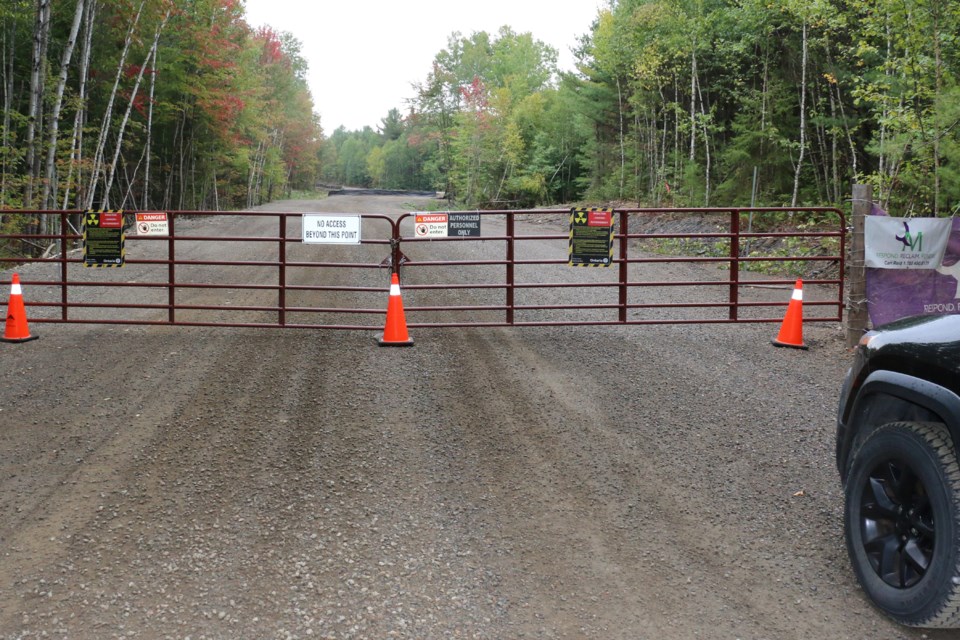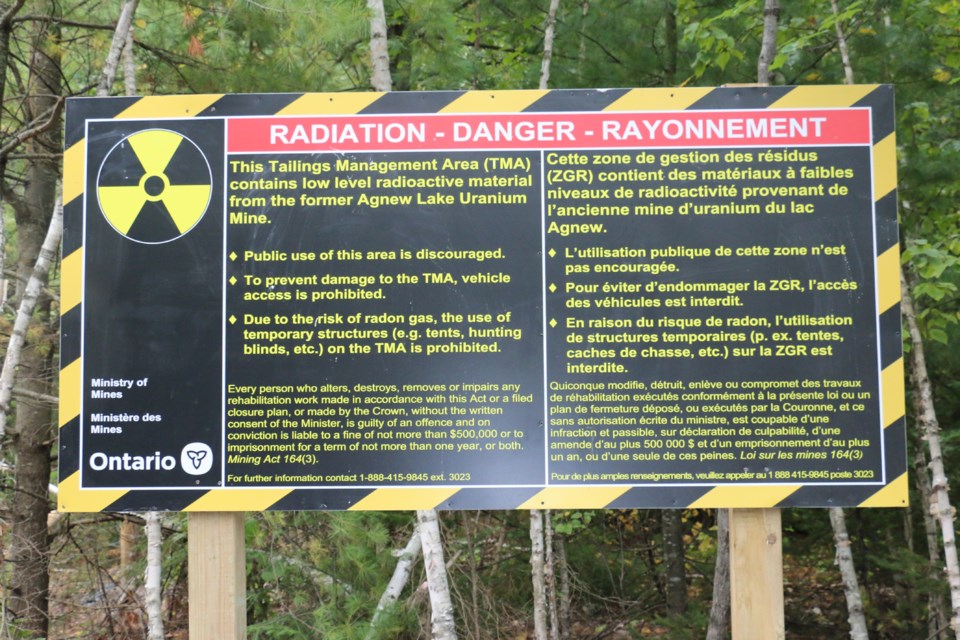As community residents in Nairn Centre gathered this week to hear plans to truck in niobium tailings from the North Bay area, they were told one of the key reasons was to use the material backfill as cover material for the real radioactive concern: the uranium tailings at the old Agnew Lake Tailings Management Area.
The idea to truck niobium to Agnew Lake is part of a long term plan by Ontario’s Ministry of Transportation (MTO) to clean up niobium tailings and naturally occurring niobium on the Nipissing First Nation lands near North Bay, which also includes a gravel pit owned by MTO.
The uranium tailings are left behind from the operations of the former Agnew Lake uranium mine and mill that operated half a century ago.

While Nairn Centre residents have been speaking out about concerns over the trucking plan, government officials have made it clear that their concern is not for the niobium, but for maintaining the integrity of the uranium tailings site which has been eroded in some areas.
Dana Pandolfi, an inspector with Canadian Nuclear Safety Commission (CNSC), told the meeting there is a concern that the ground cover at the Agnew Lake site has deteriorated over the years, exposing the radioactive uranium tailings to the environment, and that needs to be fixed.
The idea of using niobium tailings and backfill material is not the concern for her agency, she said.
Pandolfi said the main concern at Agnew Lake is covering up those eroded areas, with or without the niobium backfill.
"If for whatever reason the niobium project doesn't go through, we at the CNSC want to make sure that the areas where the radiation doses are higher are still covered at the end of the day," Pandolfi told the meeting.
She added that the key concern for CSNC is ensuring that the top cover on the uranium tailings is thick enough that the radiation emissions do not increase.
"We at the CNSC don't regulate naturally occurring radioactive material, which is what the niobium is," said Pandolfi.
The plan to move the niobium to Agnew Lake was seen as an opportunity to solve the concern of removing the niobium from the Nipissing First Nation, said Jean Guindon, a senior manager from the Ontario Ministry of Mines. At the same time, it was decided the material is a safe covering for exposed uranium tailings at Agnew Lake.
Moving the niobium effectively solves two problems.
Guindon said his ministry holds the licence for maintaining the Agnew Lake site. He said when Ontario took over in the 1990s, there were requirements to have the site properly prepared by an engineering firm so it could accept the uranium tailings.
"It was done on a site that was suitable for uranium waste. There were some covers placed below and above the tailings to ensure that seepage drainage would be well managed for the site. So in 1983 to 1988, the site was decommissioned, and in the ’90s, the Government of Ontario inherited the site," said Guindon.
He presented a slide with a map of the Agnew Lake site that showed a large wilderness area outlined in blue.
"That blue area that you see is a heat map from the radiation that's coming off the site,” Guindon said, referring to the ministry’s monitoring of the site.
And while the tailings management area certainly contains pockets of radiation from the uranium tailings stored there, members of the public do criss-cross the site on ATVs and sleds.

“We want to make sure that the site covered, which is the whole area in blue, is maintained in a way which is safe, and in order for us to conduct inspections and ensure that you know the site is safe for those recreational users, because this is Crown land, after all, so we're not restricting access."
Guindon said this open access approach contributes in part to erosion of the engineered ground cover on top of the tailings. He used a map to show areas where radiation has been detected.
"So you can see there that we have a couple of areas, I think they're marked A, B and C, and those are the areas that we have the highest radiation numbers, because the cover material is being eroded," said Guindon.
"It's a 45-year-old site. It has to be maintained, as I mentioned. But over 45 years, there's windblown erosion, there is water erosion, there are plants, there are trees, there are roots, there's animals — so there's erosion that happens naturally,” he said.
“There's also people that access the site, and this is something we're trying to discourage, which is ATVs, motorbikes, dirt bikes. This is, after all, an engineered cover, which has a lot of material that has to be brought in and is costly," said Guindon.
He said the Ontario mines ministry was aware the MTO was looking to dispose of niobium from the Nipissing First Nation and from there determined that the niobium tailings would be a good fit as a top cover for Agnew Lake. The MTO plan is to dispose of 34,000 tonnes of material.
The niobium will be used to cover the truly radioactive tailings, helping sequester them.
It is estimated that the addition of 34,000 tonnes of niobium material would provide a new cover for the tailings to a thickness of one metre at the centre, tapering off to about 30 centimetres at the edge.
CNSC inspector Pandolfi also commented on the fact that the Agnew Lake site is not a restricted area for the public.
Despite the uranium tailings stored there, she added that the Agnew Lake site is safe for "casual users", and explained how that works.
"It is safe for casual use and by casual use, if you're walking on it, if you're hunting in the area, that's fine. But the minute there's an ATV, you're taking a chance on destroying the cover," said Pandolfi.
She added that everytime an inspection is carried out, CSNC notices that signs are missing. Pandolfi said some people might think it's cool to have a radiation warning sign in their rec room as a conversation piece, but missing signs leave the wrong impression for other land users who may not know they're visiting a uranium tailings area.
The plan for trucking niobium into the Agnew Lake area is currently on hold under various Ontario government ministries that can provide more information to municipal leaders in the communities of the Townships of Nairn and Hyman, and the nearby Baldwin Township.
Len Gillis covers mining and health care for Sudbury.com.
